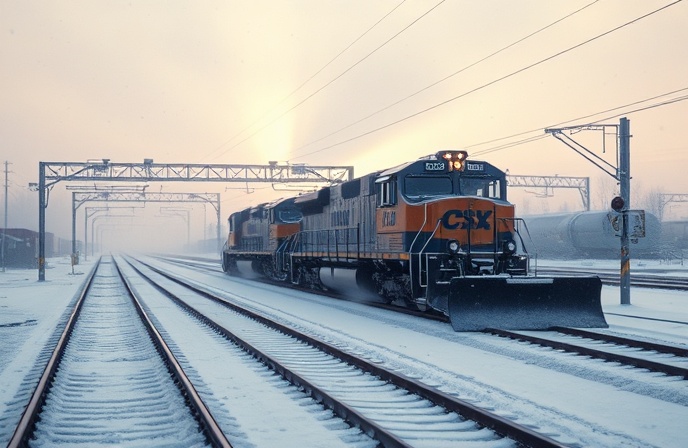Canada’s Rail Network: A $33.1M Investment in Resilience

Enhancing Canada’s Rail Network: A Strategic Investment in Supply Chain Resilience
Canada’s robust economy relies heavily on efficient transportation networks, with railways playing a crucial role in moving goods across the vast landscape. This article explores a recent CAD 33.1 million (approximately USD 23.3 million) investment by the Government of Canada, channeled through the National Trade Corridors Fund (NTCF), aimed at strengthening six key rail infrastructure projects in Alberta and British Columbia. This strategic funding is designed not only to improve the fluidity of freight and passenger rail services but also to bolster supply chain resilience and stimulate economic growth. The projects represent a diverse range of improvements, from upgrading aging infrastructure to implementing cutting-edge digital technologies. Each initiative directly addresses specific bottlenecks and inefficiencies within the Canadian rail system, underscoring a concerted effort to modernize and optimize rail transportation for the future.
Modernizing Aging Infrastructure: Bridge Upgrades and Yard Expansions
Several projects focus on upgrading existing infrastructure to meet contemporary standards and increase capacity. The Battle River Railway (BRR) upgrade, receiving CAD 5.7 million (USD 4.01 million), highlights this focus. This investment will upgrade three bridges to Class 1 standards (the highest classification for railway bridges), ensuring safety and allowing for heavier loads. In addition, the project includes development of the Forestburg Industrial Park, constructing 15,000 square feet of rail infrastructure to service the park. This expansion will improve efficiency and alleviate potential bottlenecks. Similarly, the Richardson International’s North Shore Railyard Expansion project, receiving CAD 5 million (USD 3.5 million), will add 15 new storage tracks at the North Vancouver Terminal, improving railcar handling and storage capacity. The project also involves track realignment and the addition of new infrastructure to enhance overall operational efficiency and support regional trade.
Expanding Capacity and Connectivity: Inland Ports and Siding Extensions
Addressing the need for increased capacity and improved connectivity are projects focusing on expanding rail access and establishing new intermodal facilities. Canadian National Railway (CN) will receive CAD 10 million (USD 7.05 million) for the Jaleslie Siding Extension project, which aims to improve freight and passenger rail services to and from the Port of Vancouver. This strategic siding addition will provide an additional passing option for long trains on the single-track corridor between Kamloops and the Port, enhancing operational efficiency and reducing delays. The NSD Inland Port project in Terrace, BC, receiving CAD 6.2 million (USD 4.3 million), focuses on developing a multi-commodity inland port facility. This project is crucial for enhancing transportation fluidity and intermodal connectivity in Northwestern BC, opening up new opportunities for regional trade and economic development.
Leveraging Technology: Digitalization of the Rail Supply Chain
Recognizing the importance of technology in optimizing rail operations, the NTCF has invested in projects designed to modernize and digitize aspects of the supply chain. Quasar Platform’s project, receiving CAD 3.5 million (USD 2.4 million), aims to create a digital platform for real-time monitoring of railcars and freight using approximately 10,000 GPS location sensors. This real-time data integration will provide valuable insights into rail network performance, enabling proactive management of goods movement and improved decision-making. This project aligns perfectly with the broader trend of implementing Intelligent Transportation Systems (ITS) within the railway industry.
Improving Port Efficiency: Off-Dock and Transloading Enhancements
Addressing congestion and improving efficiency at key ports is also a priority. The IntermodeX Logistics project, receiving CAD 2.7 million (USD 1.9 million), will build a new container yard and establish a transloading facility at the Port of Prince Rupert. This will significantly reduce container congestion and enhance transloading services, accelerating the movement of goods through the port. The project’s focus on improving port efficiency reflects the importance of optimizing the entire supply chain, from origin to destination.
Conclusion
The Canadian government’s CAD 33.1 million investment in these six rail projects represents a significant step towards strengthening the nation’s supply chain resilience and promoting economic growth. The projects demonstrate a multifaceted approach, addressing various challenges within the rail system. The focus on upgrading aging infrastructure, expanding capacity, leveraging technology, and improving port efficiency ensures a holistic improvement of the rail network. The modernization of bridges and rail yards improves safety and operational efficiency, while the development of new inland ports and siding extensions significantly increases capacity and connectivity. The incorporation of digital technologies, through real-time monitoring and data analytics, provides crucial insights into network performance, enabling more efficient management and decision-making. Finally, improvements at key ports help alleviate congestion and optimize the flow of goods throughout the entire supply chain. In summary, this strategic investment is not just about upgrading infrastructure; it’s about creating a more efficient, resilient, and technologically advanced rail network that will underpin Canada’s economic prosperity for years to come. The success of these projects will be instrumental in ensuring the continued competitiveness of Canadian businesses in the global market and facilitating the seamless movement of goods across the country. The long-term benefits extend beyond immediate economic impacts, contributing to improved safety, enhanced environmental sustainability, and a more reliable transportation network for all Canadians.





